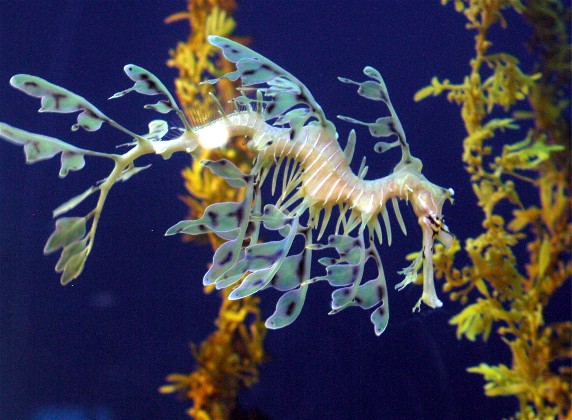- Leafy sea dragon
Taxobox
name = Leafy sea dragon
status = NT | status_system = IUCN3.1
trend = unknown

image_width = 250px
regnum =Animal ia
phylum = Chordata
classis =Actinopterygii
ordo =Syngnathiformes
familia =Syngnathidae
genus = "Phycodurus"
genus_authority = Gill,1896
species = "P. eques"
binomial = "Phycodurus eques"
binomial_authority = (Günther,1865 )The leafy sea dragon, "Phycodurus eques", is a marine
fish related to theseahorse . It is the only member of the genus "Phycodurus". These creatures are found around southern and westernAustralia and generally remain in shallow, temperate waters. Their name comes from their appearance, with long leaf-like protrusions coming from all over the body. These protrusions are not used for propulsion; they serve only ascamouflage . The leafy sea dragon propels itself by means of a pectoral fin on the ridge of its neck and a dorsal fin on its back closer to the tail end. These small fins are almost completely transparent and difficult to see as they undulate minutely to move the creature sedately through the water, completing the illusion of floating seaweed.Much like the seahorse, the leafy sea dragon's name is derived from its resemblance to another creature (in this case, a mythical sea monster from Irish legends, called the "Cler"). While not large by
sea monster standards, they are very large for sea horses, growing at least 18 inches (45 cm). They feed onplankton and small crustaceans. Females deposit eggs on the tail of the male where they grow to maturity. They have become endangered throughpollution and industrial runoff as well as collection by fascinated divers who are entranced by their unique appearance. In response to these dangers they have been officially protected by the Australian government.A related species is the
weedy sea dragon , which is multi-coloured and grows weed-like fins and can be much smaller than the leafy sea dragon. In the November 2006 issue of National Geographic magazine, marine biologist Greg Rouse is reported as investigating the DNA variation of the two sea dragon species across their ranges.The leafy sea dragon is the official marine emblem of the state of
South Australia . A biennialLeafy Sea Dragon Festival is held by theDistrict Council of Yankalilla ,South Australia . It is a festival of the environment, arts and culture of the southernFleurieu Peninsula , with a theme of celebrating the leafy sea dragon. The inaugural festival in 2005 attracted over 7000 participants and visitors. [http://www.yankalilla.sa.gov.au/site/page.cfm?u=199]Keeping sea dragons
Sea dragons are protected by Australian law. Obtaining them is often an expensive and difficult process as they must be from captive bred stock, and exporters must prove their broodstock were caught before collecting restrictions went into effect, or that they had the correct licenses to collect them. To date, no successful, closed cycle, captive-breeding program has occurred (ie getting a generation of captive-raised sea dragons to breed). Sea dragons have a specific level of protection under fisheries legislation federally and in most Australian states where they occur, such that it is illegal to take or export them without a permit.
They are very fragile and unstable outside their natural habitats. Success keeping them has been largely in the public aquarium sector, due to funding and knowledge that would not be available to the average aquarium enthusiast.
Reproduction
As with seahorses, the male Leafy Sea Dragon cares for the eggs. The female produces up to 250 bright pink eggs, then passes them on to the male's tail via a long tube. The eggs then attach themselves to a brood patch, which supplies them with oxygen. It takes a total of nine weeks for the eggs to begin to hatch, depending on water conditions. The eggs turn a ripe purple or orange over this period. After this period, the male pumps its tail until the infants emerge, a process which takes place over 24-48 hours. The male aids in the babies hatching by shaking his tail, and rubbing it against the seaweed and rocks. Once born, the
infant sea dragon is completely independent from its parents, eating smallzooplankton until large enough to huntmysids . Leafy sea dragons take about one month to reach sexual maturity. [http://www.sims.org.au/research/seadragonsuts.cfm ]Relatives
The Leafy Sea Dragon is a cousin of the
pipefish and belongs to the family Syngnathidae, along with the seahorse. The Leafy Sea Dragon differs from the seahorse in its appearance, form of locomotion, and the Leafy Sea Dragon's inability to coil or grasp things with its tail.Movement
The Leafy Sea Dragon uses the fins along the side of its head to allow it to steer and turn. However, its outer skin is solid, limiting its mobility.
Camouflage
The lobes of skin that grow on the Leafy Sea Dragon give it the appearance of seaweed, allowing it to blend in easily with its surroundings. Its leafy appearance also allows it to appear to move through the water like a piece of floating seaweed. The Leafy Sea Dragon can also change color to blend in, but this ability relies on the sea dragon's diet, location, and stress levels.
Threats
Leafy Sea Dragons are subject to many threats, both natural and man-made. They are caught by collectors, and used in
alternative medicine . They are vulnerable when first born, and are slow swimmers, reducing their chance of escape from a predator or other threat. They are also very fragile and thus are tossed around easily in storms, and can be ruptured by changes in water pressure.Food
The Leafy Sea Dragon has a long, pipe-like snout that it uses to feed. It primarily eats crustaceans including plankton and mysids, but its diet also includes shrimp and other small fish. It catches its prey using its camouflage ability. Leafy sea dragons oddly enough do not have teeth, which is rare amongst animals that eat small fish and
shrimp .Habitat
Wikimedia Foundation. 2010.
